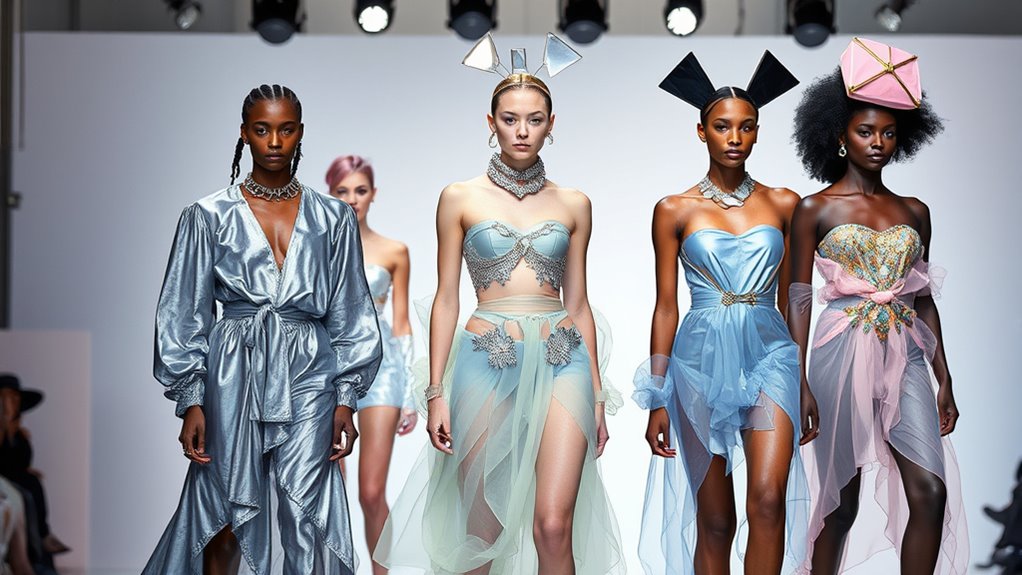Emerging designers to watch are redefining fashion by focusing on sustainability, gender-fluidity, and innovative technologies. They are using eco-friendly materials, incorporating traditional craftsmanship into modern styles, and experimenting with digital textiles that respond to touch and light. These talents blend cultural stories with avant-garde designs and challenge norms with bold shapes and sustainability at their core. If you want to explore these trailblazers and the trends they’re setting, there’s more to discover ahead.
Key Takeaways
- Emerging designers are pioneering sustainable practices using recycled materials and eco-friendly dyes to set new industry standards.
- They are blending gender-fluid and culturally inspired designs to promote diversity and self-expression.
- Innovative use of digital technologies and responsive textiles creates interactive, boundary-pushing fashion experiences.
- Cutting-edge fabric techniques and avant-garde styles challenge traditional silhouettes with bold shapes and unexpected materials.
- The focus on cultural fusion and modern minimalism combines tradition with innovative design for fresh, impactful aesthetics.
The Rise of Sustainable Fashion Innovators
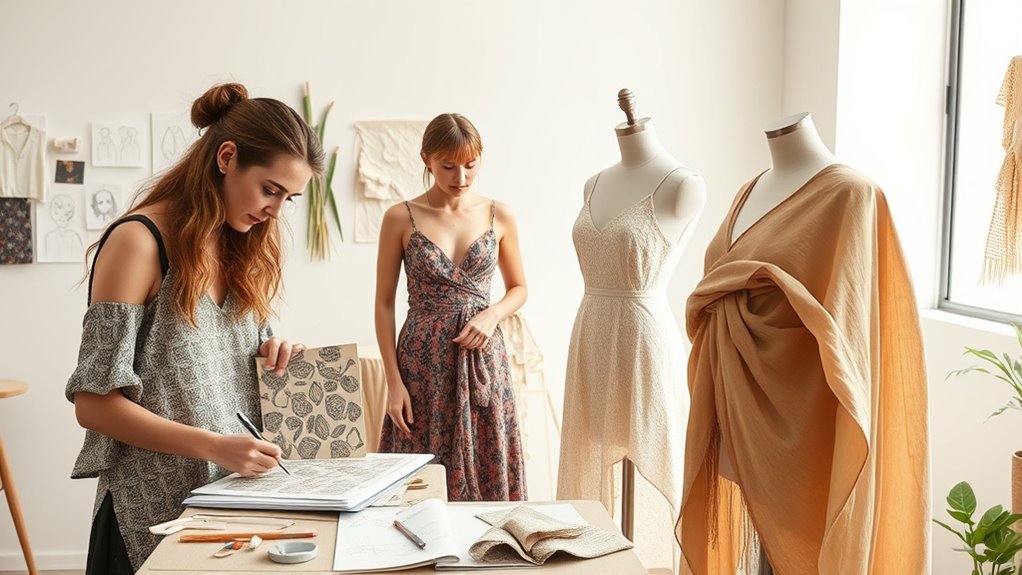
As sustainability becomes a crucial focus in the fashion industry, innovative designers are leading the charge to redefine what it means to create stylish yet eco-friendly clothing. You’ll notice these pioneers prioritize using recycled materials, organic fabrics, and low-impact dyes. They challenge traditional production methods, aiming to reduce waste and carbon footprints at every step. These designers are not just creating fashion; they’re shaping a movement that values transparency and ethical practices. By embracing circular design principles and eco-conscious sourcing, they inspire you to rethink your wardrobe choices. Incorporating principles of sound design into their collections—such as innovative presentation techniques and immersive displays—further enhances their message. Their commitment to sustainable fashion demonstrates how creativity can drive positive environmental change. Understanding the core personality traits of these innovators reveals their resilience and forward-thinking approach, which fuels their success. Their use of sound healing science techniques in presentation and branding creates memorable, emotionally resonant experiences for consumers. Additionally, these designers often incorporate biophilic design principles to connect consumers more deeply with nature through their work. As a consumer, you now have the power to support these trailblazers and contribute to a greener, more sustainable future.
Breaking Boundaries With Gender-Fluid Designs
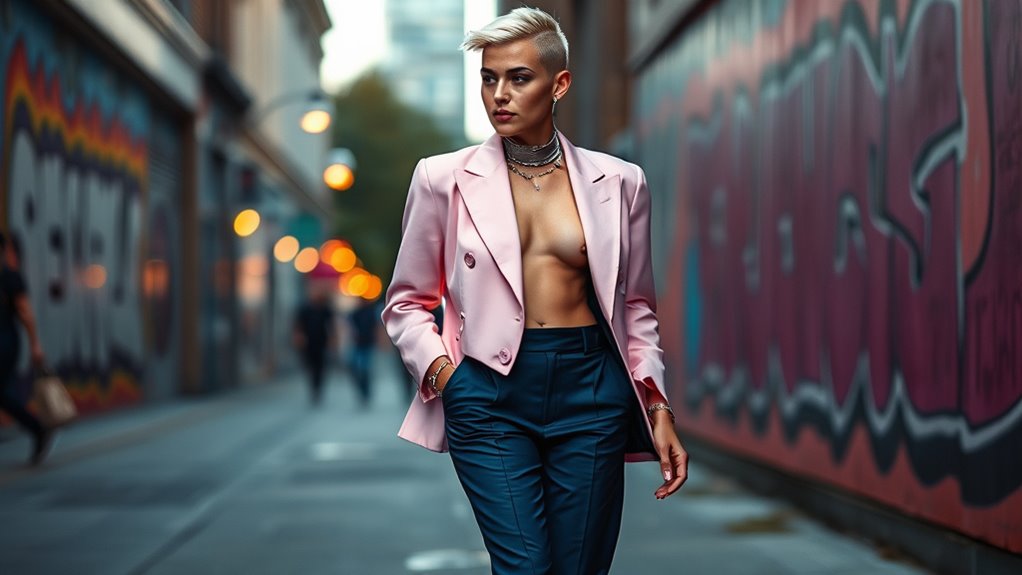
Have you noticed how gender boundaries in fashion are dissolving? More designers are challenging traditional labels by creating gender-fluid collections that anyone can wear. You’re seeing styles that blend masculine and feminine elements, emphasizing self-expression over stereotypes. These designers prioritize versatility, offering pieces that adapt to individual identities rather than fitting into rigid categories. Bright colors, unconventional silhouettes, and layered looks become tools to break norms. This inclusive approach to design empowers you to define your style freely, without conforming to societal expectations. Additionally, creativity extends beyond fashion into everyday objects, encouraging personal expression in all areas of life. Recognizing how limits can inspire innovative solutions, many designers are leveraging constraints to push boundaries further and foster inclusive design. As this trend grows, you’ll find more options that celebrate diversity and encourage personal expression beyond outdated boundaries.
Tech-Infused Textiles and Digital Artistry
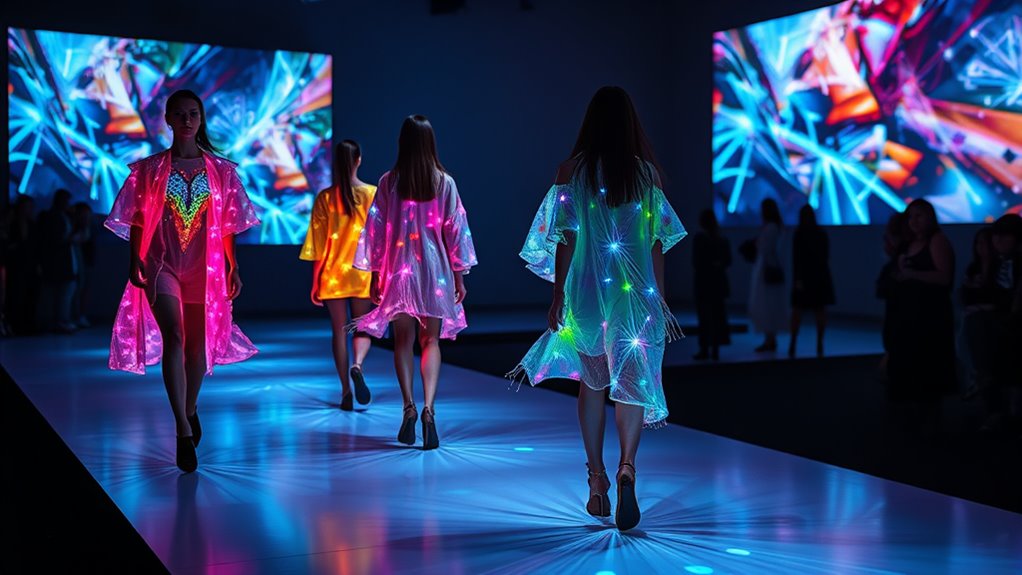
You’ll notice how emerging designers are transforming fabrics with innovative technologies that respond to touch, temperature, or light. Digital art is seamlessly integrated into textiles, creating dynamic and interactive designs. This fusion of tech and craftsmanship is redefining the future of fashion and artistic expression. Moreover, the integration of technology in education is fostering new creative possibilities for designers and artists alike. Staying informed about evolving resources and tools can further enhance a designer’s ability to incorporate cutting-edge innovations into their work. As automation and AI-driven design become more prevalent, designers can explore new workflows and creative processes that push the boundaries of traditional craftsmanship. Additionally, understanding honey varieties and their unique properties can inspire innovative textile dyes and natural ingredients in sustainable fashion. Embracing sustainable materials and eco-friendly practices is also becoming essential in contemporary design processes.
Innovative Fabric Technologies
Innovative fabric technologies are revolutionizing fashion by blending traditional craftsmanship with cutting-edge digital advancements. You can now incorporate smart textiles that respond to environmental changes, like temperature or humidity, enhancing comfort and functionality. Wearable fabrics embedded with sensors enable real-time health monitoring or adaptive features, making garments more interactive and personalized. Eco-friendly materials, such as bio-fabrics and recycled fibers, reduce environmental impact without sacrificing style. Advanced knitting and weaving techniques allow for seamless, complex designs that were once impossible. These innovations open new creative possibilities, enabling you to craft garments that are not only aesthetically striking but also technologically advanced. Additionally, the integration of industry trends like rising earnings among female musicians and the growing rivalry between AEW and WWE reflects a broader shift towards innovation and diversification in entertainment and fashion industries. As a result, fashion becomes more sustainable, functional, and aligned with the digital age’s demands. Moreover, advancements in textile manufacturing enable faster production cycles and customization options, meeting the evolving needs of consumers worldwide. Incorporating material science breakthroughs further enhances the durability and versatility of fabrics, expanding the possibilities for innovative designs. This synergy between technology and textiles is paving the way for a new era of fashion innovation that prioritizes sustainability and user experience. Additionally, the development of water-resistant and quick-drying fabrics is particularly impactful for activewear and outdoor apparel, reflecting ongoing trends in functional fashion.
Digital Art Integration
Digital art integration in fashion takes the innovative fabric technologies a step further by merging visual creativity with textile design. You’ll see designers using digital printing, LED lighting, and responsive textiles to create dynamic, interactive garments. These innovations allow you to wear art that can change patterns or display digital images in real time. This intersection of technology and fashion pushes boundaries and offers new ways to express identity and emotion. Additionally, understanding industry trends, such as voice over jobs, can open new opportunities for designers to incorporate multimedia elements into their work. Embracing wearable technology further expands the possibilities for artistic expression in fashion. The integration of interactive textiles is also transforming how garments engage with wearers and viewers alike.
Cultural Heritage Meets Contemporary Style
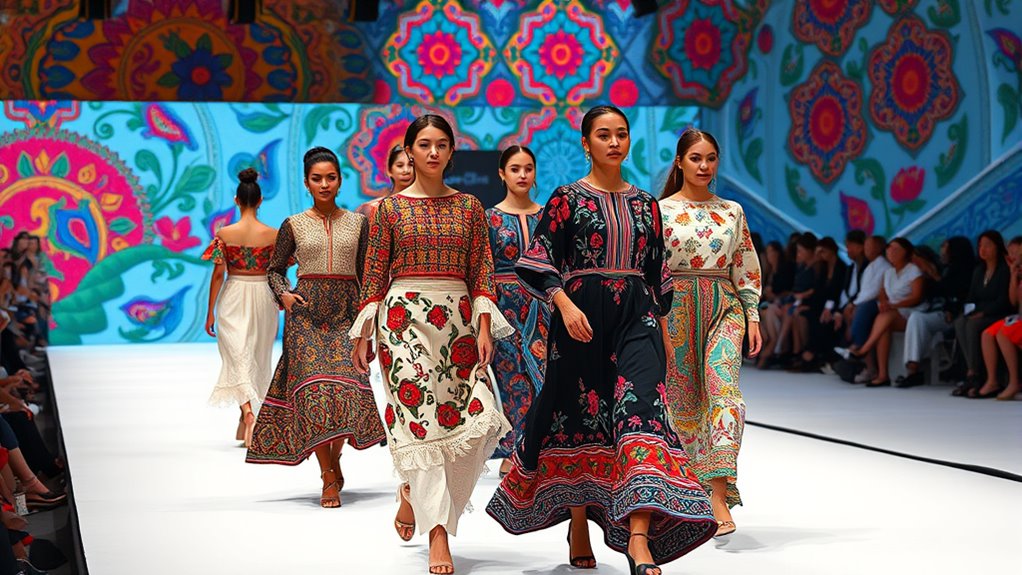
As designers increasingly blend cultural heritage with contemporary style, they create bold, meaningful fashion statements that honor tradition while appealing to modern tastes. You’ll notice how they incorporate traditional patterns, fabrics, and craftsmanship into fresh silhouettes and innovative designs. This fusion celebrates identity and history, making each piece a storytelling artifact with a modern twist. You may see vibrant embroidery from Africa, intricate beadwork from Indigenous cultures, or textile techniques reimagined for today’s runway. By doing this, emerging designers connect past and present, fostering cultural appreciation and dialogue. Their work pushes boundaries, proving that traditional techniques aren’t static but adaptable, vibrant, and relevant in contemporary fashion. The incorporation of cultural symbolism further deepens the narrative, emphasizing the cultural significance behind each design. Additionally, these designers often utilize sustainable practices to ensure their work respects both cultural heritage and environmental concerns. Incorporating innovative materials allows for new forms of expression while maintaining the integrity of traditional craftsmanship. This approach not only preserves heritage but also sets new, culturally rich trends that resonate globally.
Minimalism Reinvented by Young Visionaries

Young designers are transforming minimalism with bold fabric choices and innovative textures that catch the eye. They’re also redefining sleek, streamlined silhouettes to create fresh, modern looks. This movement proves that less can be more, with a daring twist. Additionally, their creativity extends into themed celebrations and styling for events like Halloween, showcasing how costume design and decorative elements can push boundaries while maintaining simplicity.
Innovative Fabric Choices
Innovative fabric choices are transforming minimalism into a bold statement of creativity. Young designers are experimenting with unexpected materials like recycled plastics, bio-fabrics, and metallic textiles, pushing the boundaries of traditional minimalism. Instead of relying on simple fabrics, they incorporate textures and finishes that add depth and intrigue without cluttering the design. These materials often have eco-friendly origins, aligning fashion with sustainability goals. You’ll notice sleek garments made from transparent or reflective fabrics that catch light in new ways, creating a sense of movement and energy. This approach redefines minimalism from plain and subdued to dynamic and expressive. As a result, you get clean lines combined with innovative textures, giving minimalist design an avant-garde edge that’s both fresh and forward-thinking.
Streamlined Silhouette Trends
Emerging designers are redefining minimalism by embracing sleek, streamlined silhouettes that emphasize clean lines and effortless elegance. You’ll notice how they strip away unnecessary details, focusing on precise cuts and simple shapes that make a bold statement. These designers use innovative tailoring to create garments that fit perfectly, enhancing your natural form without excess fabric or embellishments. The goal isn’t to overcomplicate; it’s to highlight the beauty of simplicity. You’ll find monochrome palettes and structured designs that exude confidence and sophistication. This trend encourages you to invest in versatile pieces that can easily shift from day to night. By reinventing minimalism, these young visionaries prove that less truly is more, offering a fresh take on timeless elegance for modern wardrobes.
Avant-Garde Looks That Challenge Norms
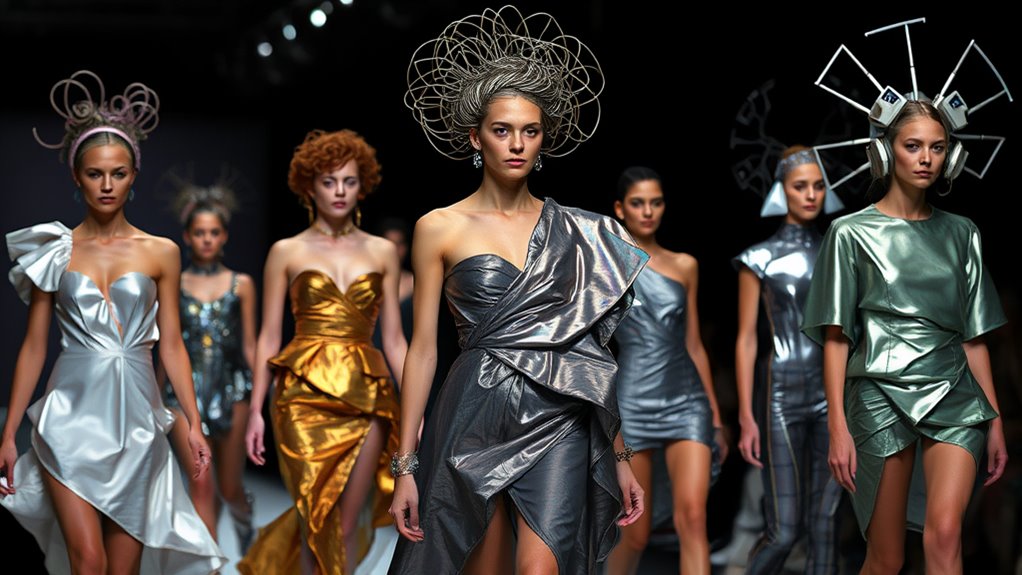
As designers push boundaries, avant-garde looks are reshaping what fashion can be. They challenge traditional ideas of beauty, structure, and function, encouraging you to see clothing as artistic expression. Expect bold shapes, unexpected materials, and disruptive silhouettes that defy norms. These innovative designers experiment with asymmetry, oversized forms, and contrasting textures, making each piece a statement. Here’s a visual breakdown of ideas:
| Element | Description | Impact |
|---|---|---|
| Oversized Shapes | Exaggerated proportions | Commands attention |
| Unconventional Materials | Metallics, plastics, unconventional fabrics | Creates visual surprise |
| Asymmetry | Irregular cuts and designs | Adds dynamism |
| Structural Elements | Architectural shapes and forms | Challenges traditional structure |
| Mixed Textures | Combining smooth, rough, shiny surfaces | Adds depth and complexity |
This approach pushes fashion beyond norms, inspiring you to embrace bold individuality.
Eco-Friendly Materials and Ethical Production

Many designers now prioritize eco-friendly materials and ethical production processes to create fashion that respects both the planet and its people. You’ll notice their use of sustainable fabrics like organic cotton, hemp, and recycled polyester, which reduce environmental impact. These designers also guarantee fair labor practices, transparent supply chains, and minimal waste. They often partner with local artisans and implement innovative techniques to lessen their carbon footprint. By choosing materials that are renewable and biodegradable, they challenge fast fashion’s throwaway culture. Your role as a consumer becomes more impactful when you support brands committed to sustainability. These designers prove that style and responsibility can go hand in hand, setting a new standard for the industry’s future. Their work demonstrates that ethical choices can be both fashionable and environmentally conscious.
Fusion of Traditional Craftsmanship and Modern Aesthetics
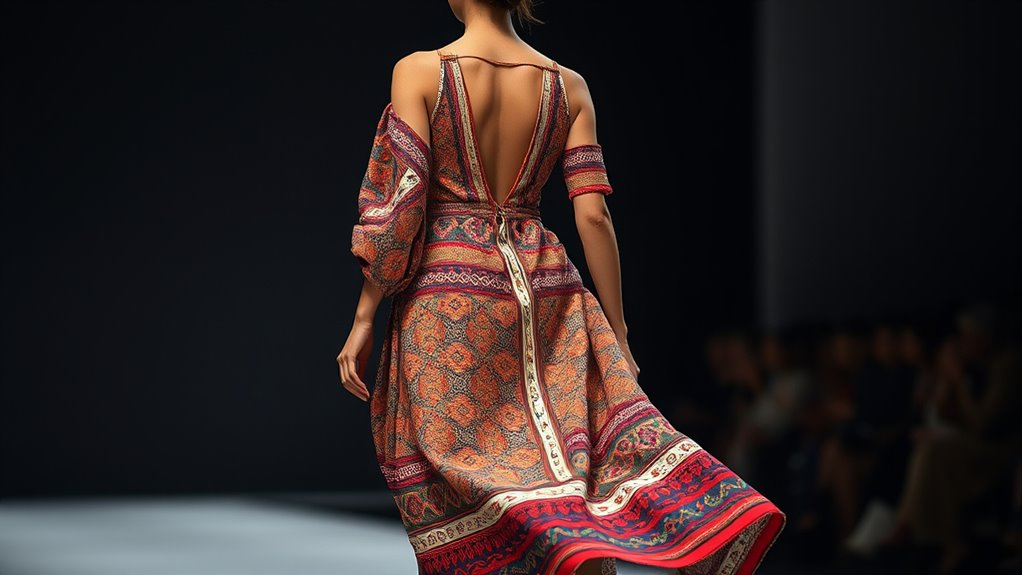
Designers are increasingly blending traditional craftsmanship with modern aesthetics to create unique, culturally rich fashion pieces. You’ll notice how they incorporate age-old techniques like embroidery, weaving, or hand-carving into contemporary silhouettes and bold designs. This fusion results in pieces that honor heritage while appealing to current tastes, making each item a statement of identity and innovation. You might see intricate beadwork paired with sleek, minimal shapes or handcrafted textiles used in futuristic garments. This approach not only celebrates craftsmanship but also pushes fashion boundaries, creating a fresh dialogue between past and present. As a consumer, you get to experience fashion that’s meaningful, authentic, and visually striking—an artful blend that sets new standards for creative expression.
Influences From Streetwear and Urban Culture
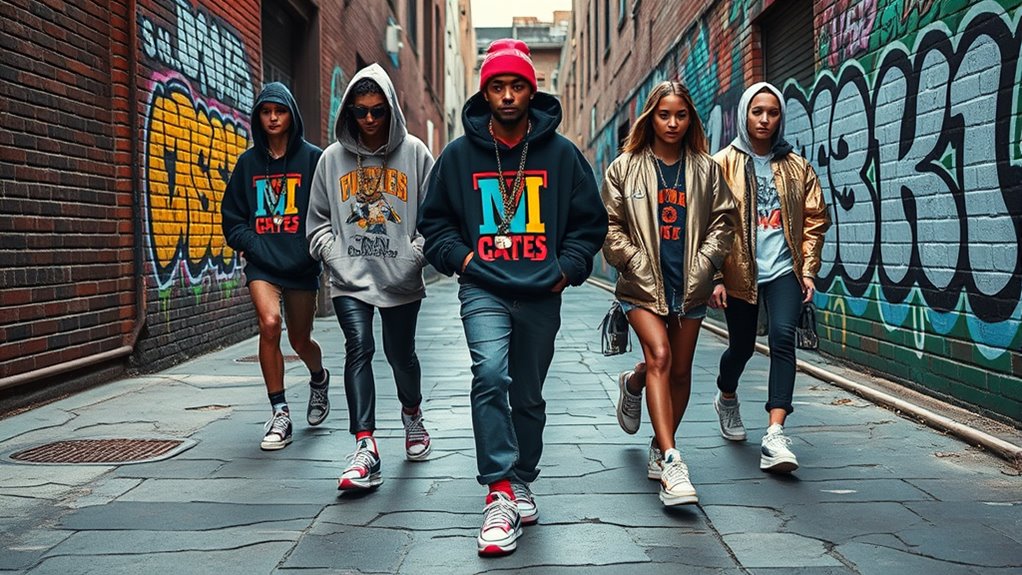
Streetwear and urban culture are now powerful sources of inspiration for emerging designers, fueling their creativity with bold graphics, oversized silhouettes, and athletic influences. You’ll notice how these elements challenge traditional fashion norms, emphasizing comfort, individuality, and self-expression. Bright colors, graffiti-inspired prints, and logo-heavy designs reflect street culture’s rebellious spirit, while technical fabrics and sporty details bring a modern edge. As a designer, you draw from skateboarding, hip-hop, and street art to craft collections that resonate with a younger, diverse audience. These influences push boundaries, blending casual with high fashion. By incorporating streetwear’s raw energy and authenticity, you create pieces that are not just trendy but also culturally relevant, making your work stand out in the evolving fashion landscape.
Frequently Asked Questions
How Do Emerging Designers Gain Recognition in the Fashion Industry?
You can gain recognition in the fashion industry by showcasing your unique designs through social media platforms, attending major fashion events, and collaborating with influencers. Building a strong online presence helps you connect with industry insiders and potential buyers. Participating in fashion competitions and submitting your work to fashion weeks also boosts visibility. Consistently innovating and establishing your brand’s identity will attract attention from critics, buyers, and the press alike.
What Inspires the Unique Aesthetics of New Fashion Innovators?
You’re curious about what fuels new fashion innovators’ unique aesthetics. Often, it’s a blend of contrasting influences—vintage meets futuristic, tradition versus innovation—that sparks creativity. You’ll find inspiration in diverse sources like art, technology, and cultural shifts, challenging norms and pushing boundaries. This juxtaposition fuels their originality, helping them craft fresh, compelling styles that stand out in the industry. It’s this daring mix that sets emerging designers apart.
How Do Young Designers Balance Tradition and Modernity?
You can balance tradition and modernity by respecting timeless techniques while embracing innovative ideas. Incorporate classic elements into your designs, but give them a fresh twist with contemporary fabrics or silhouettes. Stay true to cultural roots, yet remain open to new influences. By blending history with modern aesthetics, you create unique pieces that honor the past while appealing to today’s fashion-forward audiences. This harmony keeps your work relevant and authentic.
What Role Does Technology Play in Contemporary Fashion Design?
Technology plays a pivotal role in contemporary fashion design by enabling you to innovate and streamline your creative process. With digital tools like CAD software, you can experiment with new patterns and styles more efficiently. 3D printing allows you to create complex, customized garments. Social media helps you showcase your work to a global audience, gaining feedback and building your brand. Embracing technology lets you stay ahead in a fast-evolving industry.
How Are Sustainability and Ethics Integrated Into Emerging Fashion Brands?
You’re probably curious how sustainability and ethics subtly shape modern fashion brands. You’ll notice that these brands often embrace eco-friendly materials, prioritize fair labor practices, and minimize waste, all while maintaining stylish designs. They actively seek transparent supply chains and support social causes, making responsible choices seem natural. By integrating these values seamlessly into their identity, they inspire you to appreciate fashion that’s both innovative and conscientious.
Conclusion
As you explore these emerging designers, remember they’re the seeds of change, planting bold ideas in the fertile ground of fashion’s future. Their innovative visions act as lanterns, guiding us through a landscape of sustainability, diversity, and creativity. Embrace their symbolism—each stitch and silhouette representing a step toward a more inclusive, eco-conscious world. By supporting them, you become part of a movement that transforms fashion into a catalyst for hope and renewal.
